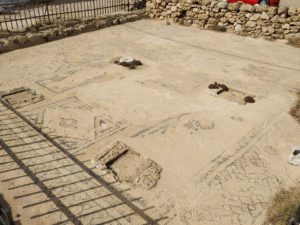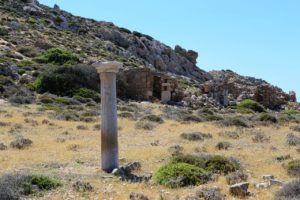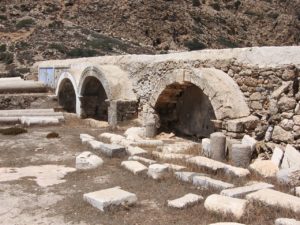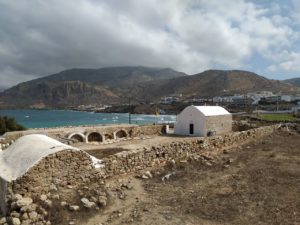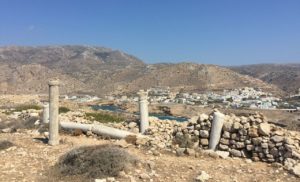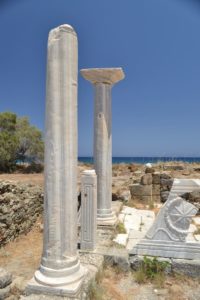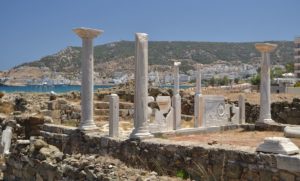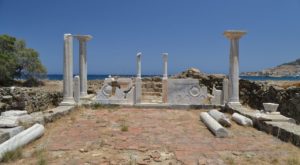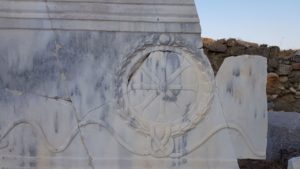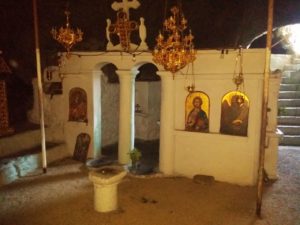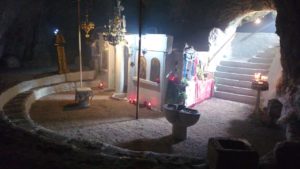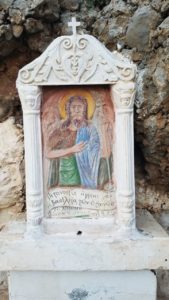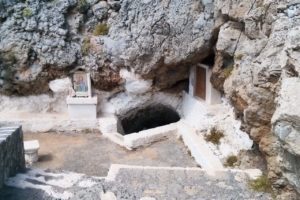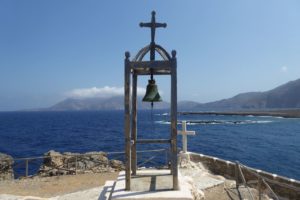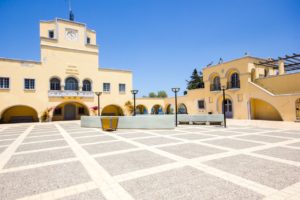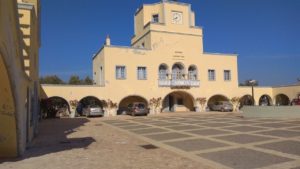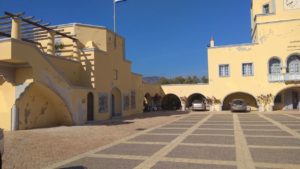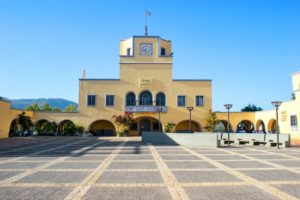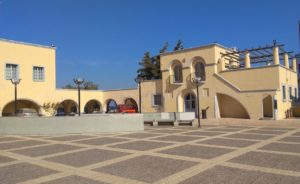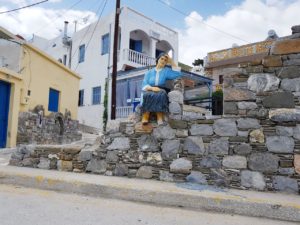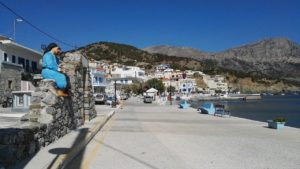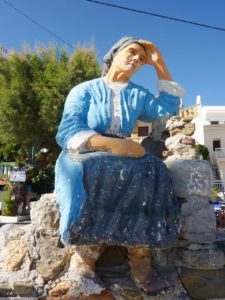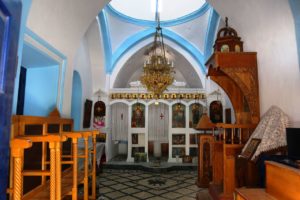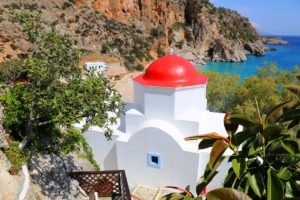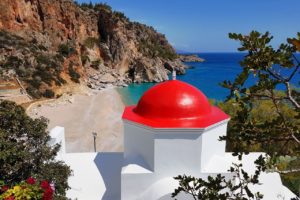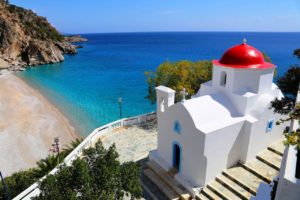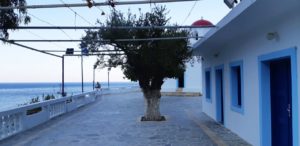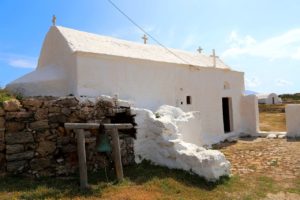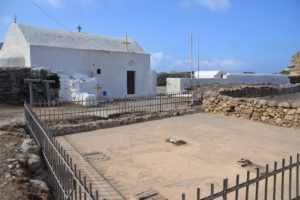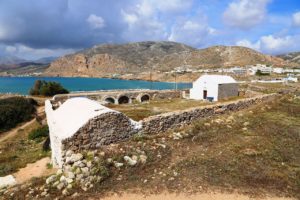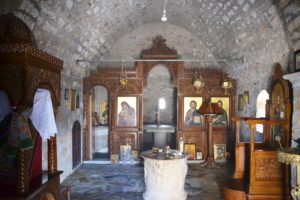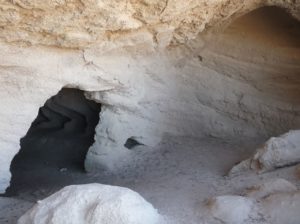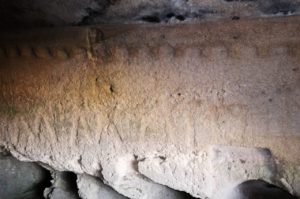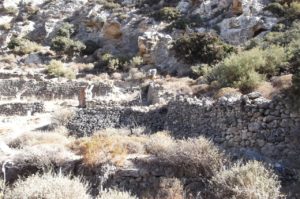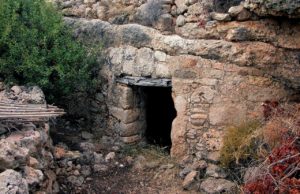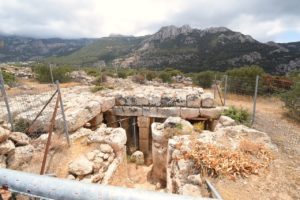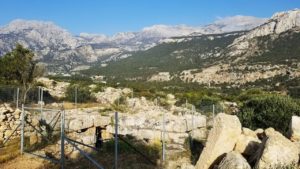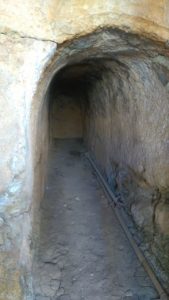Acropolis of Arkassa
The archaeological site of Arkassa, one of the four municipalities of classical and later times, consists of the Acropolis of Paleokastro with obvious remains of fortifications of Archaic times and towers of the classical and Hellenistic era. Remains of buildings and reservoirs are also preserved in good condition.
The lifespan of the settlement cannot be determined because there is no evidence from the excavation data.
In the archaeological site there are ruins of buildings and tanks in good condition. The foundations of a three-aisled basilica of the early Christian period with semicircular arches and monolithic marble columns are preserved. North-northeast of Paleokastro lies the plain of Arkassa with two ports in use since antiquity.
Two early Christian basilicas have been excavated by Italian archaeologists during the period of the Italian occupation.
The first and largest, but also the closest to the ports is the early Christian basilica of the Elder Alypos. After being destroyed in the early 6th century AD, the basilica was rebuilt with rich mosaic floors and inscriptions mentioning Bishop Cyrus and the name of the saint to whom the basilica was dedicated, known as Saint Anastasia.
The second large basilica that was excavated by the same excavators is the basilica of the elder Euharistos.
There are three other early Christian basilicas in the area of Arkasa, one of which is the cemetery of Archangel Michael. On the eastern side of the settlement there are two Middle Byzantine churches, Panagia Marmarini and Agios Georgios.
Source: ODYSSEUS
Ruins of the Ancient Church of Ag. Fotini
In Pigadia, at the beginning of the road leading to Aperi, the ruins of Agia Fotini, a three-aisled early Christian basilica of the 5th – 6th century, have been uncovered in the position “Afoti”. The church, with rich marble interior decoration, is located in the place where an ancient sanctuary probably existed.
Saint John Broucunda
Northeast of Olympus, at the edge of the cape of Vroukounda, there is a large natural cave, inhabited since the Minoan-Mycenaean era. Entering by boat into the clogged bay, one cannot realize the size of the ruins of the ancient city. Ancient Vrykus of the Dorians may have experienced its greatest heyday in the 4th-3rd centuries BC. The ancient city is completely sealed and the carved tombs are empty tombs.
The inhabitants consecrated the place in the centuries that followed (three early Christian basilicas of the 5th-6th century have been recorded by the archaeological service) and at the edge of the cape in an invisible cave, they used ancient material to honour St John of Vroukunda. Descending the stone steps of the cave, the visitor-pilgrim faces the sanctuary of the rudimentary church. The biggest and most important festival of Karpathos takes place here on 28-29 August and the residents of Olympus, Vlora and Diafanios have the first say.
Province
In Pigadia Karpathos, in a prominent position, is the complex of three buildings of the Karpathos District. These are characteristic buildings of the Italian era, built during the period 1926-36. They have a flat roof and are built with the Italian mixed construction (masonry with horizontal and vertical elements of lightly reinforced concrete). These buildings were the Italian headquarters and similar buildings were built by the Italians on every island of the Dodecanese to make their presence felt. Today they belong to the Greek State.
They belong to the category of buildings with characteristics of “International Style” and some elements of oriental eclecticism. It is a composition of three buildings, arranged in a “P” shape, thus forming and delimiting Alexandrou Papagos Square. The central building is taller (up to 4 floors), thus dominating with its volume and morphology. The other two buildings, with their volume (up to 2 storeys) and their morphology (pergolas on the floor, etc.) frame the central building without competing with it. All three buildings are connected to each other by semi-open spaces and arches, thus forming a whole that embraces the square. An ensemble with a very “strong” plan and morphology with full and empty spaces for light, air and views. Observing the complex from the square, we can see the symmetry and accentuation of its central axis, which is the highest point of the building, with the clock and the flagpole.
The complex was designated as a historical monument in 1997, as these are remarkable buildings of the Italian occupation in the Dodecanese and are important for the study of architecture. The west wing houses the archaeological museum of the island.
Monument to the Olympian woman
A sculpture of an aged woman, dressed in traditional clothes, looking towards the sea, waiting for the return of those who have emigrated, paying tribute to the expatriates and the contribution of the Olympian women. Emigration helped the development of the place through the remittances sent by their compatriots from abroad but it was also a plague for the Carpathians. These feelings are reflected in the figure of the woman who waits with patience for the expatriates.
Church of Kyra Panagia
The church of Kyra Panagia stands on a rock next to the sea, in the homonymous settlement southwest of Pigadia.
Dating back to the 6th century, the church of Kyra Panagia stands on a rock next to the sea, in the homonymous settlement southwest of Pigadia.
Agia Sophia Arkassa
It is built with building materials from an ancient temple at the root of the rock of Paleokastro in the place where there was the early Christian basilica of Agia Anastasia of the 5th century.
It has an elaborate floor and a historic swimming pool that escaped the pirate corsairs. Tradition has it that the pirates had plundered the church and loaded the booty onto their ship. The swimming pool was found floating in the sea and the believers placed it back in the temple.
Excavations in the area were carried out by the Italian conquerors in 1924 who brought to Rhodes remarkable findings.
The whole courtyard has mosaics that unfortunately have been worn away by time.
Poseidon Cave
The cave of Poseidon is located at Mili. Leaving Pigadia southwest towards Vroutsas and entering the narrow passage where the torrent that flows into Pigadia flows, on your left hand you will find an area with dry stones and half-graved buildings.Stop and find the path that in the direction of Menetes leads parallel to the road to the rock and the cave.
It is a monumental carved tomb or sanctuary. The type was very common in the eastern Aegean. The cave probably housed a sanctuary dedicated to the god of the sea, Poseidon, or the goddess of love, Aphrodite. There are indications that there was a wooden roof in front. It may have been a sanctuary of Aphrodite, a goddess popular among the popular classes. Speculation about Aphrodite is based on the fact that archaeologists have found statuettes of the goddess in the surrounding area. Statuettes of the goddess have also been found in Pigadia.
It is most likely that the open-air sanctuary of the goddess was the Cave of the Virgin, which we find 2 km away, in the area of Vathypotamos. The cave has been eroded by constant use by shepherds.
Roman Aqueduct White
One of the best preserved monuments of Karpathos. It is located in Lefko, on the southwest coast of the island. Its main feature is the underground reservoir, carved into the rock.
It consists of a central rectangular hall measuring 4X9 m. with three rows of pillars, on which are supported four rows of rectangular plates that form its roof.
On its northern narrow and eastern long side there are seven blind galleries with vaulted roofs. Their inner walls and roof, like the walls of the central hall, are coated with a thick layer of hydraulic mortar.

